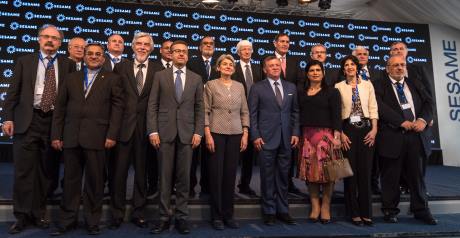Jordan inaugurates region's first synchrotron
17 May 2017
King Abdullah II of Jordan yesterday officially opened the Middle East's first particle accelerator. Scientists from across the region will use the Synchrotron-light for Experimental Science and Applications in the Middle East (SESAME) for advanced research projects.
 |
| King Abdullah (third from right) at the inauguration ceremony, which was also attended by senior representatives from the IAEA, CERN, UNESCO, and SESAME members (Image: CERN) |
Synchrotrons are particle accelerators that produce intense light from the electromagnetic radiation generated by electrons moving almost at the speed of light. The precise beams of light produced include microwave, infrared, visible, ultraviolet, X-ray and gamma-ray light. Under controlled conditions, researchers can use these beams to look at materials with great precision. There are currently around 50 synchrotron light sources in the world.
Located at Allan in Jordan, the first synchrotron light source in the Middle East is also the region's first international centre of excellence. It is modelled on the European Organisation for Nuclear Research (CERN) and was developed under the auspices of the United Nations Educational, Scientific and Cultural Organisation (UNESCO) with support from the International Atomic Energy Authority (IAEA).
The project has cost some $90 million to date. Staff costs, power and other operational costs are provided by annual contributions from the joint venture's members of Cyprus, Egypt, Iran, Israel, Jordan, Pakistan, the Palestinian Authority and Turkey. Capital funding has been provided by the governments of Jordan, Israel, and Turkey, the Royal Court of Jordan, and by the European Union (through CERN and directly) and Italy.
SESAME's first electron beam was circulated on 11 January, and the design energy of 2.5 GeV was reached on 27 April. The light source is equipped with beamlines that focus the light on the samples to be studied, with each beamline capable of supporting several experiments at the same time. Two beamlines will be in operation initially: an X-ray absorption fine structure/X-ray fluorescence spectroscopy beamline and an infrared Beamline. These will support work in areas including basic materials science, life sciences and environmental science, biochemistry, microanalysis, archaeology, geology, cell biology, biomedical diagnostics, and environmental science.
A third beamline to support materials science studies will come into operation in late 2017. A Macromolecular Crystallography beamline and a protein expression/crystallization facility for structural molecular biology will come into operation in 2019. The facility has the capacity to house a total of 24 beamlines. Fifty-five proposals to use the first two beamlines have already been submitted.
IAEA director-general Yukiya Amano, who attended the opening ceremony, said: "SESAME is an excellent example of multinational high-tech collaboration, and the IAEA is proud to be your partner. I have no doubt that the people of this region will derive great benefits from the advanced research in the various scientific areas that will be carried out here in the coming decades."
Researched and written
by World Nuclear News